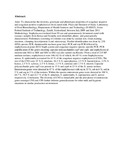| dc.description.abstract | Aims: To characterise the diversity, genotypic and phenotypic properties of coagulase
negative and coagulase positive staphylococci from camel milk.
Place and Duration of Study: Laboratory of Food Biotechnology, Department of Health
Sciences and Technology (D-HEST), Swiss Federal Institute of Technology, Zurich,
Switzerland, between July 2009 and June 2011.
Methodology: Staphylococci isolated from 59 raw and spontaneously fermented camel
milk (suusac) samples from Kenya and Somalia were identified, pheno- and genotypically
characterized. Preliminary screening of colonies was done by catalase test, Gram staining
reactions, clumping factor/protein A and microscopy. Further identification was done by 23S
rDNA species PCR, thermostable nuclease gene (nuc) PCR and rep-PCR followed by
staphylococcal genus ID32 Staph system and coagulase negative species specific PCR.
PCR amplification of the genes encoding capsular polysaccharides cap5 and cap8, and
staphylococcal enterotoxins SEA to SEE and SEG to SEJ was also carried out.Results: From a total of 235 BP medium isolates, staphylococci were 146 (62 %) of which,
66 (45 %) were Staphylococcus aureus. S. epidermidis accounted for 43 % of the
coagulase negative staphylococci (CNS). The rest of the CNS were 25 % S. simulans, 16.3
% S. saprophyticus, 2.5 % S. haemolyticus, 2.5% S. hyicus, 2.5 % S. xylosus, 2.5 % S.
lentus, 1.3 % S. carnosus and 1.3 % S. microti. Capsular polysaccharide gene cap5 was
present in 15 % and cap8 in 23 % of the S. aureus isolates. Enterotoxin genes were
detected in 47 % of the staphylococci with sej in 33 %, seb in 6 %, sed in 5 % and seg in 3
% of the isolates. Within the species enterotoxin genes were detected in 100 %, 64.7 %,
38.5 % and 22.7 % of the S. simulans, S. epidermidis, S. sapropyticus and S. aureus
respectively.
Conclusion: The diversity of CNS is remarkable and the prevalence of enterotoxin genes
amongst CNS and CPS further informs generalizations for other milk and hygienic
situations in similar production environment | en |

